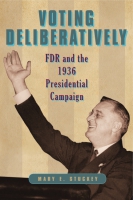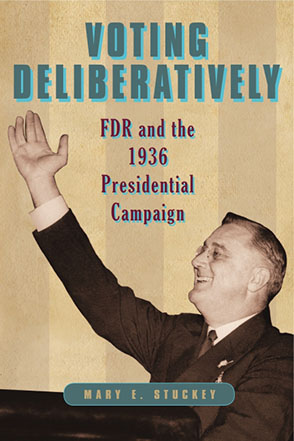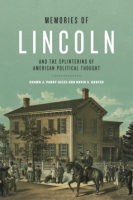Voting Deliberatively
FDR and the 1936 Presidential Campaign
Mary E. Stuckey
“Stuckey brings important perspective to the first reelection campaign of Franklin D. Roosevelt and persuasively argues for 1936 as the point at which the nation transitioned from the electoral politics born of Martin Van Buren’s genius to the modern campaigns of today. . . . Beyond the interesting story of the campaign itself, this is an important book for understanding the evolution of modern presidential politics.”
- Description
- Reviews
- Bio
- Table of Contents
- Sample Chapters
- Subjects
“Stuckey brings important perspective to the first reelection campaign of Franklin D. Roosevelt and persuasively argues for 1936 as the point at which the nation transitioned from the electoral politics born of Martin Van Buren’s genius to the modern campaigns of today. . . . Beyond the interesting story of the campaign itself, this is an important book for understanding the evolution of modern presidential politics.”
“Drawing on multiple archival sources and her own previous research on FDR, Mary Stuckey has produced the definitive account of the 1936 presidential campaign. If anyone wants to trace our contemporary campaigns back to their source, Stuckey’s book is the place to begin. I highly recommend this book to all students of the American presidency.”
“Mary Stuckey’s Voting Deliberatively offers a fresh and innovative analysis of FDR’s campaign rhetoric and organization that makes plain the historical significance and contemporary salience of the 1936 presidential campaign. Stuckey cogently situates 1936 as a critical juncture where old practices began to fade while new practices arose, including opinion polling, building a ground game, segmenting the public, and fostering a personality-based politics. Scholars who wish to understand how presidential campaigns work and how they came to work this way should read Voting Deliberatively.”
“To the familiar portrait of Franklin D. Roosevelt as founder of the modern American welfare state, Mary Stuckey adds a fresh portrait of FDR as founder of the modern state of American campaigning. With a fine eye for paradox, she demonstrates how citizen politics was simultaneously advanced and undermined during his 1936 campaign through pioneering methods of studying, mobilizing, dividing, and addressing the electorate. For readers interested in Roosevelt’s political arts and/or in how the current mode of electing presidents was first constructed, Voting Deliberatively will be sure to fascinate.”
“Mary Stuckey has once again delivered a remarkable gift to readers across the social sciences and humanities. Weaving together several fascinating strands of archival documents, Stuckey reveals the inner workings of the FDR electoral machine as well as how the administration effectively created the modern polling subject. A must-read for students of American politics.”
“Mary Stuckey’s Voting Deliberatively: FDR and the 1936 Presidential Campaign demonstrates that the roots of many common practices that define both presidential campaigns and the ‘rhetorical presidency’ can be traced to the groundbreaking campaign of Franklin Roosevelt in 1936. Stuckey argues persuasively that the use of polling practices in 1936 set the stage for a redefinition of our understanding of the role of the public. While Roosevelt’s use of multiple means of measuring public opinion, including the then-new technology of polling, helped him overcome strident opposition, the new methods also set the stage for modern campaigns in which public opinion is reduced to a set of data points. Stuckey documents the successful efforts of the Roosevelt campaign to mobilize voters through the creation of organizations focused on the campaign and the candidate—as well as the president’s skillful appeals to various special interests in building the New Deal coalition, a political powerhouse for almost half a century. She also demonstrates that Roosevelt used his message to create a personal coalition, a result that was politically powerful but also led voters to focus on the candidate rather than the underlying ideology.”
“Clearly written and accessible to both academics and a general readership, Voting Deliberatively is a welcome addition to the literature on FDR and the 1936 election, the Great Depression, the New Deal, the history of campaigning, and American politics generally.”
“Stuckey’s research is original, relying on primary sources and culling insights that are sure to add to our overall understanding of this particular campaign and its innovative ideas and protocols. She understands Roosevelt well and is able to provide an objective assessment of the president who, as a master politician, managed partisan politics and key operatives while, at the same time, adding a coalition of extrapartisan groups such as the Good Neighbor League, the Committee of One, Roosevelt Republican League, and Friends of Roosevelt.”
Mary E. Stuckey is Professor of Communication and Political Science at Georgia State University, where she focuses on rhetoric and presidential politics. Her most recent books are Rhetoric: A Presidential Briefing Book and The Good Neighbor: Franklin D. Roosevelt and the Rhetoric of American Power.
Acknowledgments vii
Introduction: Roosevelt and the 1936 Election 1
1 Creating Public Opinion, Muting the Public’s Voice
2 Empowering the Public, Privileging the Candidate
3 Mobilizing the Vote, Containing the Public 66
4 Speaking for the Public, Empowering the Presidency
Conclusion: The Mass Public and the Presidency
Notes 123 Bibliography 143 Index 151
introduction:
roosevelt and the 1936 election
A few short months before the election, the outcome seemed anything but certain. Both internal White House polls and the public polls conducted by the media supported the wide range of available anecdotal evidence: the president was in trouble. His first election, in the wake of a thoroughly discredited Republican administration, had once seemed to hold the promise of Democratic dominance for the foreseeable future. But continuing economic prob- lems, a controversial domestic agenda, and a foreign policy that seemed weak and vacillating eroded the administration’s support among the mass public. The administration was attacked every day on the nation’s mass media and the president faced vicious and unrelenting criticism from both the Right and the Left, some of it aimed at his policies, much of it directed at the person of the president himself. Such criticism even escalated into the formation of a new political party dedicated, it appeared, exclusively to undermining the president and attacking his programs. From all the available evidence, then, it seemed unlikely that the president was about to make history.
But his reelection was indeed historic. Franklin Delano Roosevelt won the 1936 election with nearly 61 percent of the vote, capturing forty-six of the forty- eight states, losing only in Maine and Vermont. Looking back at that result and knowing, as we do now, the entirety of the legacy left to us by FDR, it is easy to forget how contestable—and how contested—his administration actu- ally was.1 It is also easy to overlook the innovations of that campaign and the consequences they had for the practices of American democracy.2 This book
2 voting deliberatively
examines that campaign with an eye toward understanding an underexam- ined moment in our national history and analyzing how the elements of that campaign reveal contemporary patterns in American elections as delibera- tive events.3 Specifically, I argue that there are several constituent elements of Roosevelt’s 1936 election campaign, none of which have received appropriate attention, and all of which contributed to his victory then and have proved foundational for the way campaigns and politics more broadly are conducted now. Each of these elements affects the ways in which the American mass pub- lic participates in and is understood through national elections. They are also integral to contemporary patterns of democratic deliberation. Roosevelt’s con- duct of the 1936 election is a particularly good way to access these elements because it stands at the intersection of differing understandings of campaigning and American politics. That election thus allows us to look both backward and forward, to more fully comprehend what has been gained and was has been lost as the center of American politics shifted from states to the federal level and American influence began to be felt internationally.
I am not positing this election as the moment of breakdown in the Ameri- can system, in which all prior elections were characterized by healthy forms of deliberation and all later ones evidence of the collapse of deliberation and democracy. The problems of democratic deliberation in a republic are legion and have never been solved. There has been no golden age of American democ- racy in which an inclusive polity has carefully debated relevant policy and in which republican forms of representation have been perfectly enacted. In fact, there is and always has been a tension between inclusion and efficiency, and there has always been a tendency among those who are included to generalize their interests to that of the “public interest.”4 This election is interesting partly because those problems and potential solutions were very much on the minds of those involved in the Roosevelt campaign. Their solutions, such as they were, had some beneficial and also some perverse effects, both of which are with us today. It is with the hope of better understanding their politics as well as our own that I focus on 1936.
I look closely at four elements of the Roosevelt campaign as revealing of the shifts in the way the public and its deliberative role in American politics are understood. I treat “the public” here in the informal, rather than in the Haber- masian sense. That is, I am not interested in how these practices created or failed to create a healthy theoretical public sphere so much as I am concerned with how practical politicians sought to include, exclude, organize, mobilize,
introduction 3
and manage the electorate. As Janet M. Atwill has noted, models of civic vir- tue are tied to political practice.5 By closely examining those practices, we can learn a great deal about how citizenship was understood then and continues to inform our contemporary politics.
Each of the elements I examine involves something of a paradox of delib- eration and democracy in the American republic. First, the 1936 Roosevelt campaign involved both older and emerging models of assessing public opin- ion. That campaign made extensive use of personal and partisan contacts and also developed new methods of aggregating and tracking opinion by polling. This meant that FDR and his aides had a broad and deep understanding of the electorate as a public and could carefully calibrate how they understood its opinions. As Roosevelt sought to include a greater number of (white) people in the public and to open up American politics and expand his coalition, it became concomitantly more difficult to apprehend either the public itself or its collective views. Public-opinion polling allowed Roosevelt to aggregate opin- ion but would increasingly do so at the expense of other, more nuanced ways of understanding that opinion. The public, then, became larger and less well understood, more able to participate in politics and also less able to articulate its preferences.
Second, the 1936 Roosevelt campaign, relying as it did on the mobilization of a broad swath of the mass public, was one of the first national campaigns to depend on what we now call the “ground game.” Scholars and pundits alike consider Franklin D. Roosevelt an eloquent speaker, a master of radio, a public communicator par excellence and understand these traits as fundamental to his political success.6 Focusing on Roosevelt’s communicative skill, however, can lead us to overlook his dedication to organizational politics.7 His 1936 campaign used a variety of mobilization techniques that are now commonplace but which were, for their time, revolutionary. As politics based on elites increasingly gave way to mass politics, mobilization of a diverse electorate became a critical com- ponent of national politics, and the president, rather than the party, became the center of political organization. Roosevelt worked with his party, but also relied on extrapartisan organizations. The paradox here is that as the nation became in some ways more democratic, it did so within structures that were specifi- cally republican, putting major stresses on the system. The federal government’s response to those stresses led to an increase in national and presidential power, which undermined both the democratic and republican impulses of national institutions and weakened the ability of the public to articulate itself through its
4 voting deliberatively
political institutions. Roosevelt helped give us candidate-centered campaigns and president-centered government.
Third, faced with the need to mobilize the mass public, Roosevelt in 1936 approached the polity as a composite of different kinds of interests. Paradoxi- cally, then, he created a unified coalition by first fragmenting the electorate into groups, some of which had significantly more access than others. Mobilizing the public by demographic group created a certain view of public opinion, enabling the development of interest-group politics and a group-based, pluralistic view of what and who the public are.8 Voters and citizens were less able, as indi- viduals, to articulate interests that concerned government. Instead, individuals came to be understood as constituted by their group membership, identities that either facilitated access or precluded it. As the electorate expanded (and it remained restricted in important ways during the Roosevelt years), national campaigns engaged in increasingly mediated ways of segmenting the public into fragmented units that could be identified and mobilized on the basis of specific attributes—either ascriptive (women), economic (blue-collar workers), or demographic (Protestants). But this practice also fractured political identi- ties in ways that may not be productive for the practices of republican citizen- ship. As Ira Katznelson recently noted, with politics organized around interest groups, procedural democracy came to dominate the “common good” as a structuring element of the national state.9 Group membership was specifically connected with self-interest and the conception of citizenship narrowed.
Finally, I examine the ways in which FDR himself sought to reconcile these paradoxes through his public rhetoric. That rhetoric depended, in large part, on the creation of a new kind of political authority, grounded in the person of the president. While serving to nationalize American politics and helping to create an American state, Roosevelt’s rhetoric also forged a personality-centered view of national politics that tends to reduce deliberative possibilities, impoverish- ing discussion of issues, institutions, and processes and focusing instead on the character of candidates and elected officials. The 1930s were notable for the rise of plebiscitary politics, which are associated with a personalized understand- ing of politics, reliance on public opinion, and the spectacular: government had increasingly to be seen to be understood as legitimate.10 Roosevelt enabled the rhetorical presidency and the consequent imbalance in presidential power vis-à-vis that of Congress.11 Paradoxically, then, FDR sought to facilitate delib- erative politics, often stressing the need for an educated and active electorate, and at the same time engaged in political practices that disabled some of the deliberative potential of national elections.
introduction 5
In the short run, these practices contributed to both a winning campaign in 1936 and a coalition that dominated American politics for decades. Equally important, in my view, is that they continue to affect the ways in which the public and its opinions are understood by those in power. They also affect the ways in which the public deliberates during elections and the kinds of questions that are the subject of their deliberation. Roosevelt probably never intended any of these consequences. But they are unmistakably rooted in his conception of politics and political leadership. The contours of that leadership were made abundantly clear during his first term and especially in the kinds of support and opposition generated during that term that formed the basis for his coalition building during the 1936 election.
Also of Interest
Mailing List
Subscribe to our mailing list and be notified about new titles, journals and catalogs.





